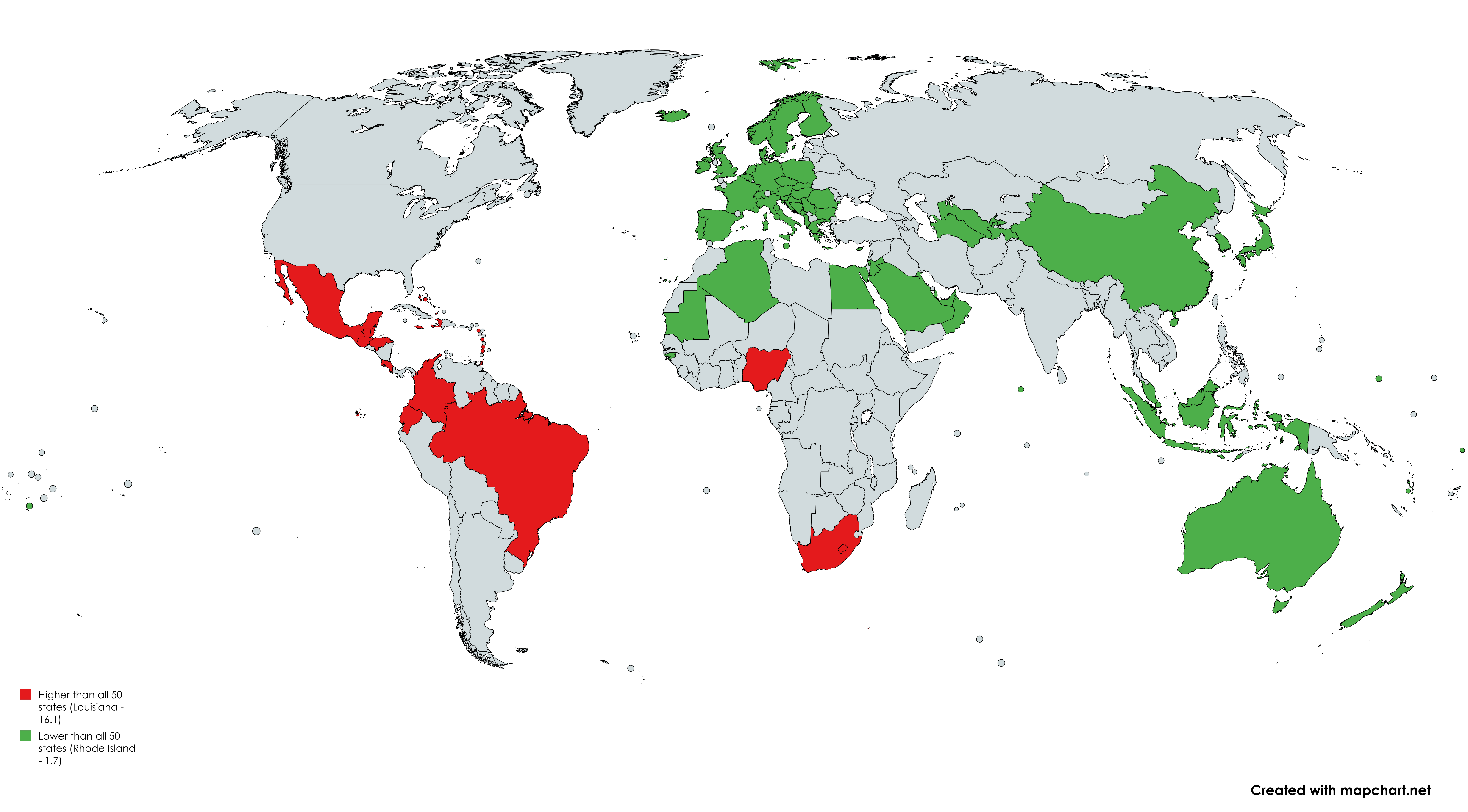Homicide Rate Comparison Map of US States


Alex Cartwright
Senior Cartographer & GIS Specialist
Alex Cartwright is a renowned cartographer and geographic information systems specialist with over 15 years of experience in spatial analysis and data...
Geographic Analysis
What This Map Shows
The "Is your homicide rate higher or lower than all the 50 US states?" map provides a comprehensive visualization of homicide rates across the United States, allowing viewers to quickly assess where their state stands in comparison to others. Homicide rates, often expressed as the number of homicides per 100,000 inhabitants, vary significantly across different states due to a multitude of factors including demographic trends, economic conditions, and law enforcement practices. This map serves as a valuable tool for understanding these disparities in a clear and concise manner.
Deep Dive into Homicide Rates
Homicide rates are a critical metric for gauging public safety and social stability. They can reflect underlying social issues, including poverty, education, and access to mental health services. As of recent statistics, the national homicide rate in the U.S. has seen fluctuations, with a notable increase in recent years attributed to various factors, including the COVID-19 pandemic, economic strain, and social unrest.
What's fascinating is how homicide rates can differ dramatically even between neighboring states. For instance, states like Louisiana consistently report some of the highest homicide rates in the nation, often exceeding 15 homicides per 100,000 residents. In contrast, states like Maine and New Hampshire frequently report rates below 2 per 100,000. These disparities can often be linked to social and economic conditions, availability of firearms, and community resources dedicated to crime prevention.
Interestingly, urban areas tend to have higher homicide rates compared to rural regions. Cities like Chicago, Baltimore, and St. Louis often dominate headlines due to their elevated homicide counts, which can skew perceptions of safety in those regions. In urban settings, factors such as gang violence, drug trafficking, and socioeconomic disparities contribute significantly to higher homicide rates.
Moreover, the influence of gun laws plays a crucial role in shaping homicide statistics. States with more permissive gun laws often see higher rates of gun-related homicides. For instance, states in the South, such as Alabama and Mississippi, have more relaxed gun regulations and correspondingly higher homicide rates. In contrast, states like California and New York, which have stricter gun control measures, typically report lower homicide rates.
Regional Analysis
When examining the map regionally, it's evident that the Southern U.S. grapples with higher homicide rates compared to the Northeast and West Coast. For example, in the South, states like Alabama and Louisiana frequently report rates that are significantly higher than the national average. In contrast, states in the Northeast, such as Vermont and Massachusetts, often enjoy lower homicide rates, thanks in part to more robust social services and community programs.
The Midwest presents a mixed picture; states like Illinois show high rates primarily in urban centers like Chicago, whereas rural areas in states like Nebraska maintain low homicide rates. Meanwhile, the West Coast, particularly California, has made significant strides in reducing homicide rates over the past few decades due to focused law enforcement efforts and community engagement initiatives.
It's also worth noting how states with large urban populations, like Texas and Florida, display a range of homicide rates influenced by both urban and rural areas within their borders. Cities like Houston and Miami contend with challenges typical of large urban centers, while rural regions may experience rates that are substantially lower.
Significance and Impact
Understanding homicide rates is crucial for policymakers, law enforcement agencies, and communities alike. High homicide rates can indicate deeper societal issues, prompting the need for systemic reforms in education, healthcare, and community development. Furthermore, increased awareness about these rates can lead to more informed discussions about public safety measures and crime prevention strategies.
Current trends suggest that while some states are seeing a reduction in homicide rates, others are experiencing alarming increases. This fluctuation raises questions about the effectiveness of crime prevention programs and the impact of socio-economic changes. As we move forward, it’s essential to continue monitoring these statistics to address the root causes of violence and promote safer communities nationwide.
By engaging with this map and the data it presents, individuals can gain valuable insights into their own communities and the broader context of crime in America. Have you noticed how your state compares? Understanding these dynamics can lead to more meaningful conversations about public safety and community well-being.
Visualization Details
- Published
- October 26, 2025
- Views
- 4
Comments
Loading comments...